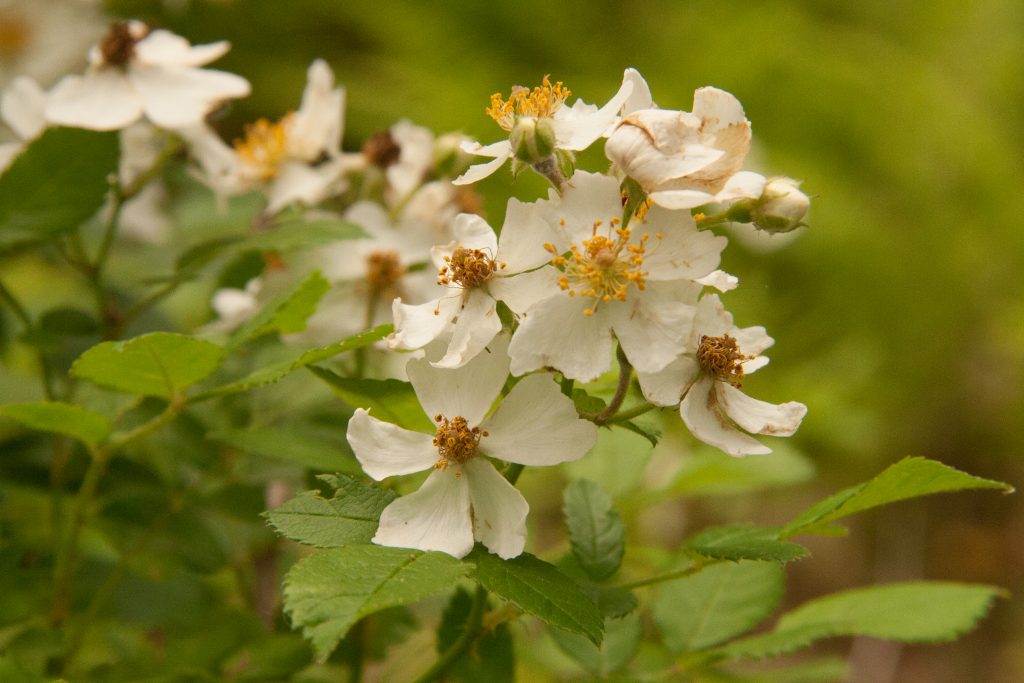
Well I guess that depends on where it’s growing, doesn’t it. In the middle of your garden bed you’d probably consider this plant a pest, but along your favorite hiking trail, you might be happy to see this fragrant bloomer, especially in late spring.
Rosa multiflora is listed as a noxious weed in many states (AL, IA, KY, MO, PA, WV), as a nuisance in one (WI), and is downright prohibited in others (CT, MA, NH). The USDA considers it invasive. Let’s face it, foragers (and other hungry, inquisitive animals) are probably the only beings happy to find the multiflora rose.
Native to Asia, the multiflora rose was introduced to the U.S. in the late 19th century as a rootstock for ornamental roses. The U.S. Soil Conservation Service actually promoted it as a living fence and for erosion control, and it was tough enough to be planted as a median strip barrier on busy highways. Rosa multiflora produces multiple, small hips, each containing numerous seeds that remain viable in the soil for years. It’s a prolific plant, and not at all particular about soil quality. It grows in both full sun and full shade, and often forms thick thickets with sharp, curved thorns that easily make holes in an unsuspecting t-shirt.
Flowers are borne in terminal clusters and range from white to pale pink. In late spring to early summer they catch your eye as you hurtle past at 65 mph. But if you want to think of Rosa multiflora as more than just a pest, you’re going to have to get out of the car and get up close and personal with the flower.
Yes, the flower. Some of you may know I’m not a big edible flower person. But there are several I deem worthy of gathering, like elderflowers, linden flowers, and yes, the petals of Rosa multiflora. The most fragrant blooms have a spicy, clove-y scent, which transfers strongly to sugars, syrups, and cream. It’s worth sniffing the flowers on individual plants. I find the scent varies greatly, even among plants growing next to each other. The most fragrant blooms will also give you the most flavor.
In case you’re wondering about the hips of the multiflora rose, yes you can eat them. Ripe hips contain lots of vitamin C and are an important winter food for birds, chipmunks, mice, rabbits, and larger mammals, like bear and deer. Because the hips are small, it’s too cumbersome (for me, anyway) to separate flesh and seeds. I juice multiflora rose hips for jelly, because that way I can mash them whole. I use larger rose hips (like those of R. rugosa and R. canina) when I need the flesh.
As a forager, I’m happy when Rosa multiflora blooms and I can collect enough petals for syrup and (wait for it) rose petal infused panna cotta. As a gardener, I wonder if I should dig up the small plant I spotted yesterday on the edge of the driveway.
So happy to read an appreciation of this exquisitely fragrant plant, and to learn these uses. My aim is to capture the scent in a water for use as a perfume. Hoping to find instructions for this as well
I’m still learning about how to capture fragrance, and I don’t know much! But I do know different substances (oil, alcohol, water) capture and preserve different fragrances, and I wish you luck! It’s pretty easy to distill your own rose water at home. I wrote about it in my cocktail book but haven’t published the article on line yet. Still, I’m sure you could google it. Maybe that will get you started.
My neighbor has this growing wildly over my fence.. It looks nice & I actually love the aroma.. It makes a great nesting spot for Cardinals.. & unfortunately, Bald Faced Hornets too.. so, be very aware.
Bald faced hornets are fierce! I’ve had a few run-ins with them.
how do you remove the hips from the stems ??
Just pick them like you would any fruit. They come off easily with your fingers.
It’s a foe, and I HATE finding it along my favorite hiking trail. Invasive plants get that label for specific reasons, and by definition are non-native. It’s nice that it has fragrant flowers you can use for syrup or whatever, but these bushes are awful in the woods, where they choke out native plants by growing in impenetrable, sunlight-blocking thickets. Encouraging them to grow anywhere means one more chance for an animal or bird to spread its seeds even further. It’s a foe.
Foe it may be, but by taking every blossom I can get my grubby little paws on, I deny the thorny buggers a chance to make seeds. Just doing my part to control invasives and getting rose blossom jam in the bargain. At least it’s usable, unlike Amur Honeysuckle or Glossy Buckthorn. I take great delight in ripping them out by the roots and burning them in my biochar barrel.
I appreciate your attitude and feel exactly the same way!